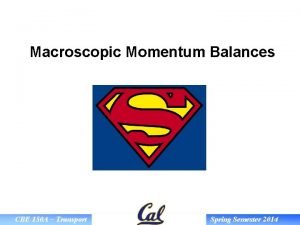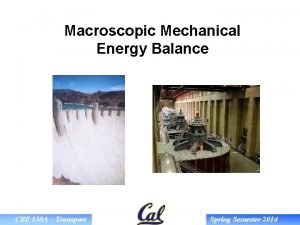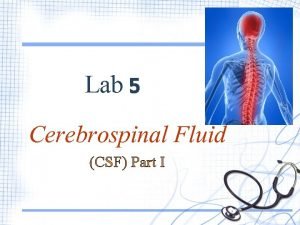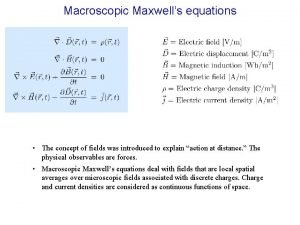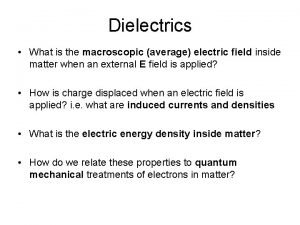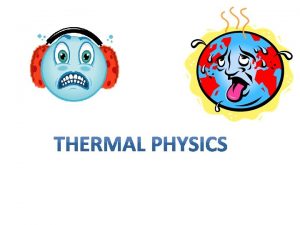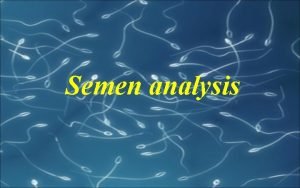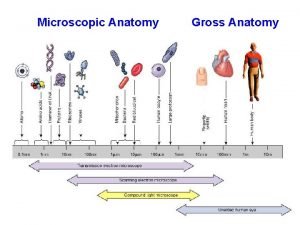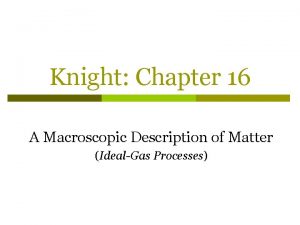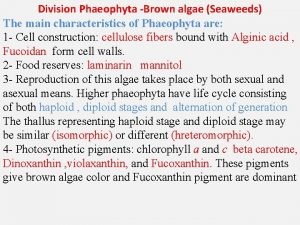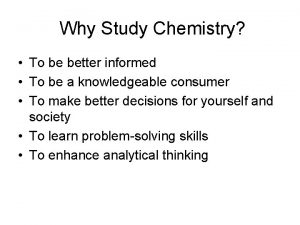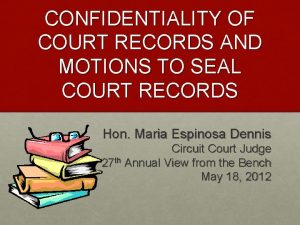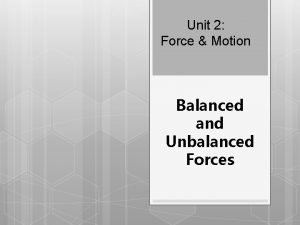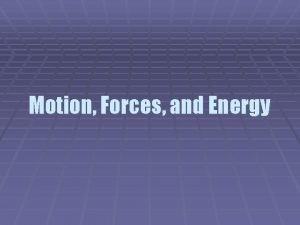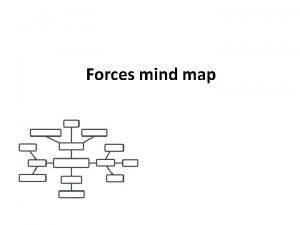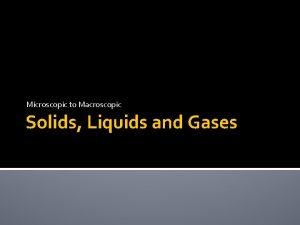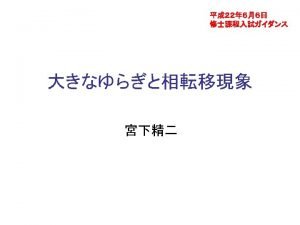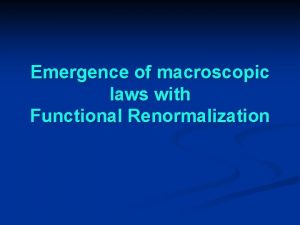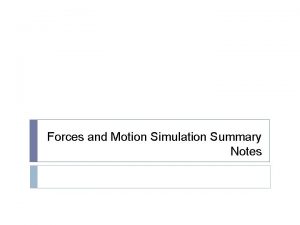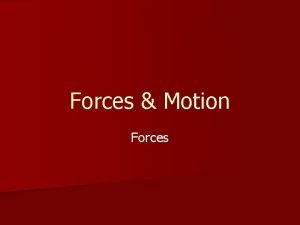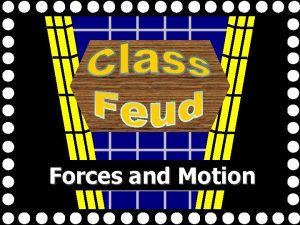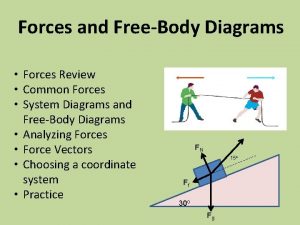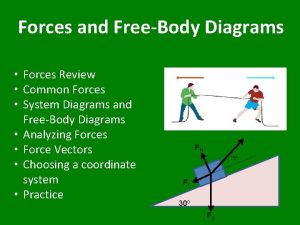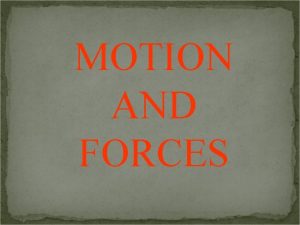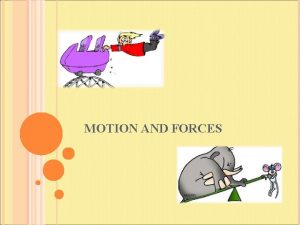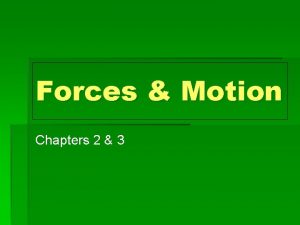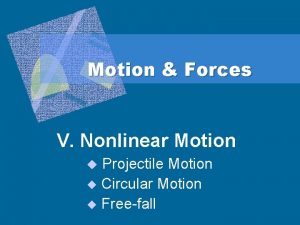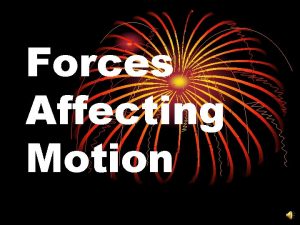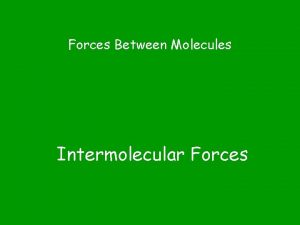Forces and Motion Review Macroscopic Forces Determine motion
























- Slides: 24

Forces and Motion - Review Macroscopic Forces - Determine motion from net forces -

What is a Force? o A force is simply a push or a pull. o Forces are Vectors so they have a magnitude and a direction. o A force applied to an object might change its shape (deformation) o A force applied to an object might affect the object’s motion

Categories of Forces o o Contact forces – requires the objects exerting the forces to touch (be in contact with) each other Her weigh t pushe s down on the chai r. Girl pulls on wagon. Field Forces – act at a distance or through space. Gravitational field Magnetic field

Force Due to Gravity o o o Gravitational forces occur because the mass of objects causes them pull together. On Earth, the gravitational force is WEIGHT. Weight on Earth is calculated by multiplying mass by 9/8 m/s/s (or about 10 m/s/s) Fg = m g Direction: always toward the center of the Earth.

Friction Force o o Frictional forces between two objects depend on the type of surfaces that are in contact with each other Direction: in the opposite direction of motion or impending motion. Ff

Elastic Force o An elastic force applied to an object deforms the object but once removed allows the object to recover its original form, length, shape. ent res h p c t e c re r t s o f s g e n Th hi t n whe. Fquish s EL or

Tension Force o The force that shows up in a string/rope as the result of its stretching is called tension force. Muscles can produce tension forces. FT No ng i h tc g n e i r t h s s i u sq r o Direction: Is always along the ‘rope’

Normal or Support Force o o Support force between and object and a solid surface Direction: it is always perpendicular to the surface at the point where the object touches it FN Direction: 90 o to surface

Buoyant Force o Force due to a liquid or gas; an object floating in or supported by liquid or air FBU OY Direction: Upward

Applied Forces o These are forces applied to an object; they can be pushes or pulls; applied forces are not a ‘type’ of force, but a source of a force in a particular problem. FApp FPu sh FPu ll

Magnetic force o Magnetic forces are non-contact (or field) forces; a magnetic force can pull an object toward itself or push it away. FEM FMAG

Common MACROSCOPIC Forces Contact or Field Force? Name: ______ Symbol Name of Force FG or Fg Gravitational force (or weight force) Fe Elastic force Contact force An elastic force applied to an object deforms the object but once removed allows the object to recover its original form, length, shape. Ff Friction force Contact force Frictional forces between two objects depend on the type of surfaces that are in contact with each other; Solid surfaces that are in contact produce friction; Air or liquids can produce frictional forces, too. FT Tension force Contact force The force that shows up in a string/rope as the result of its stretching ; Muscles can produce tension forces FN or Fn Normal force Contact force Support force between and object and a solid surface; it is always perpendicular to the surface at the point where the object touches it F buoy Buoyant force Contact force Support force due to liquid or gas ; an object floating in or supported by air or liquid. F PUSH F PULL F APP Applied force by a person or thing Contact forces applied to an object; they can be pushes or pulls; applied forces are not a ‘type’ of force, but a source of a force in a particular problem. Magnetic force Non-contact force (Field force) a magnetic force can pull an object toward itself or push it away. A magnetic field is present. F MAG Direction? Description Gravitational forces occur because the mass of objects causes them to be attracted to each other. On Earth, the gravitational force is WEIGHT. Weight is calculated by multiplying mass by 9/8 m/s/s (or about 10 m/s/s)

Common MACROSCOPIC Forces Symbol FG or Fg FEL Name of Force Contact or Field Force? Direction Gravitation al force (or weight force) Non-contact force (Field force) Toward the center of the Earth Elastic force Contact force Varies Ff Friction force Contact force Opposite direction of motion or impending motion FT Tension force Contact force Along the rope, string, etc. FN or Fn Normal force Contact force Always perpendicular (90 o) from surface. F buoy Buoyant force Contact force F PUSH F PULL F APP Applied force by a person or thing Contact force F MAG Magnetic force Non-contact force (Field force) Upward Name: ______ Description Gravitational forces occur because the mass of objects causes them to be attracted to each other. On Earth, the gravitational force is WEIGHT. Weight is calculated by multiplying mass by 9/8 m/s/s (or about 10 m/s/s) An elastic force applied to an object deforms the object but once removed allows the object to recover its original form, length, shape. Frictional forces between two objects depend on the type of surfaces that are in contact with each other; Solid surfaces that are in contact produce friction; Air or liquids can produce frictional forces, too. The force that shows up in a string/rope as the result of its stretching ; Muscles can produce tension forces Support force between and object and a solid surface; it is always perpendicular to the surface at the point where the object touches it Support force due to a liquid or gas ; an object floating in or supported by air or liquid. Varies forces applied to an object; they can be pushes or pulls; applied forces are not a ‘type’ of force, but a source of a force in a particular problem. Varies a magnetic force can pull an object toward itself or push it away. A magnetic field is present.


Vector Addition of Forces o

+4 N +3 N -3 N = +7 N = +1 N +4 N 4 N 3 N = 5 N Use the Pythagorean Theorem

3 N 3 N To the right is positive = 0 N 1 N 1 N = 0 N Up is positive When the net force is 0 , the forces are BALANCED velocity stays the same.

3 N 2 N To the right is positive = -1 N 2 N 1 N = 1 N Up is positive When the net force is NOT 0, the forces are UNBALANCED - velocity changes SO ACCELERATION OCCURS!!

Motion Implications based on Force Analysis Balanced Forces Equal Forces ΣF = 0 Static Equilibrium Dynamic Equilibrium Object is at rest. Object is moving (still) at constant v=0&a=0 velocity. v≠ 0 & a=0 Unbalanced Forces Unequal Forces ΣF ≠ 0 Disequilibrium Object accelerates in the direction of the net force.

A. 60 N Net Forces? Equilibrium? Motion? ΣF = 6 o. N + 60 N ΣF = 0 N Equilibrium? Yes, in the x and y directions. ‘x’ Motion:

B. 12 N 5 N Net Forces? Equilibrium? Motion? ΣF = 12 N + 5 N ΣF = 7 N Equilibrium? No, in the y direction. ‘y’ Motion: Accelerates upward Yes, in the x direction. ‘x’ Motion: At rest or constant vel.

C. 6. 2 N 2. 1 N 6. 2 N Net Forces? Equilibrium? ΣFy = 6. 2 N + 6. 2 N ΣFy = 0 N (y direction) ΣFx = 2. 1 N Motion? Equilibrium? Yes, in the y direction ‘y’ Motion:

A. B. 60 N C. 12 N 6. 2 N 2. 1 N 60 N ΣF = 6 o. N + 60 N ΣF = 0 N Equilibrium? Yes, in the x and y directions. ‘x’ Motion: 5 N 6. 2 N ΣF = 6. 2 N + 6. 2 ΣF = 12 N + 5 N N ΣF = 7 N ΣF = 0 N (y Equilibrium? direction) No, in the y direction. ‘y’ Motion: ΣF = 2. 1 N Accelerates upward Yes, in the x direction. Equilibrium? ‘x’ Motion: Yes, in the y direction At rest or constant vel.

1. Complete the rectangle with the vectors 3. To create a balanced force diagram, you need to place a new vector in the opposite direction (but the same magnitude). 2. Draw the diagonal of the rectangle to create the ‘Resultant’ vector. .
 Chapter review motion part a vocabulary review answer key
Chapter review motion part a vocabulary review answer key Macroscopic momentum balance
Macroscopic momentum balance Overall mechanical energy balance
Overall mechanical energy balance Csf cell count
Csf cell count Virtual urinalysis lab answers
Virtual urinalysis lab answers Macroscopic hematuria causes
Macroscopic hematuria causes Cheesy masses in sputum
Cheesy masses in sputum Maxwell
Maxwell Normaldand
Normaldand Macroscopic level meaning
Macroscopic level meaning Average motility of sperm
Average motility of sperm Levels of organization
Levels of organization Macroscopic description of an ideal gas
Macroscopic description of an ideal gas Brown algae phylum
Brown algae phylum Is milk macroscopic microscopic or particulate
Is milk macroscopic microscopic or particulate Culuture definition
Culuture definition Deduce the resultant of two like parallel forces
Deduce the resultant of two like parallel forces Contact and non contact forces
Contact and non contact forces Force examples in everyday life
Force examples in everyday life What is constructive forces
What is constructive forces Motion to determine confidentiality of court records
Motion to determine confidentiality of court records Electric forces and fields concept review
Electric forces and fields concept review Standing still balanced or unbalanced
Standing still balanced or unbalanced Motion forces and energy
Motion forces and energy Types of force mind map
Types of force mind map

